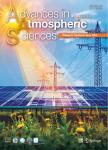Interdecadal Variability of East Asian Summer Monsoon Precipitation over 220 Years (1777-1997)
Interdecadal Variability of East Asian Summer Monsoon Precipitation over 220 Years (1777-1997)作者机构:Atmospheric Sciences Program School of Earth and Environmental Sciences Seoul National University National Institute of Meteorological Research Korea Meteorological Administration Department of Geophysics Peking University
出 版 物:《Advances in Atmospheric Sciences》 (大气科学进展(英文版))
年 卷 期:2010年第27卷第2期
页 面:253-264页
核心收录:
学科分类:07[理学] 070601[理学-气象学] 0706[理学-大气科学]
基 金:supported by the Korea Foundation for International Cooperation of Science and Technology (KICOS) througha grant provided by the Korean Ministry of Science and Technology (MOST) in 2009 and the Grant of NIMR-2009-B-2 at the National Institute of Meteorological Research Korea Meteorological Administration
主 题:interdecadal variability East Asian summer monsoon precipitation timescales dry–wet transition
摘 要:In this study, long-term (1777–1997) precipitation data for Seoul, Korea, wetness indices from eastern China, and modern observations are used to identify the interdecadal variability in East Asian summer monsoon precipitation over the last 220 years. In the East Asian monsoon region, two long-term timescales of dry–wet transitions for the interdecadal variability and quasi-40-and quasi-60-year timescales are dominant in the 220-year precipitation data of Seoul, as well as in the wetness indices over China. The wet and dry spells between Seoul (southern China) and northern China are out-of-phase (out-of-phase) at the quasi-60-year timescale, and in-phase (out-of-phase by approximately 90 ? before 1900 and in-phase after 1900) at the quasi-40-year timescale. In particular, during the last century, the dominant long-term timescales over East Asia tend to decrease from the quasi-60-year to the quasi-40-year with increasing time. The dominant quasi-40-year and quasi-60-year timescales of the Seoul precipitation in Korea are strongly correlated with these timescales of the northern Pacific Ocean.



